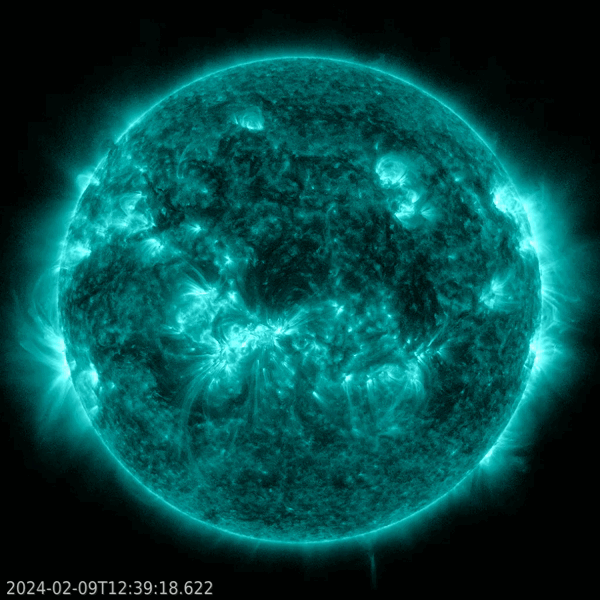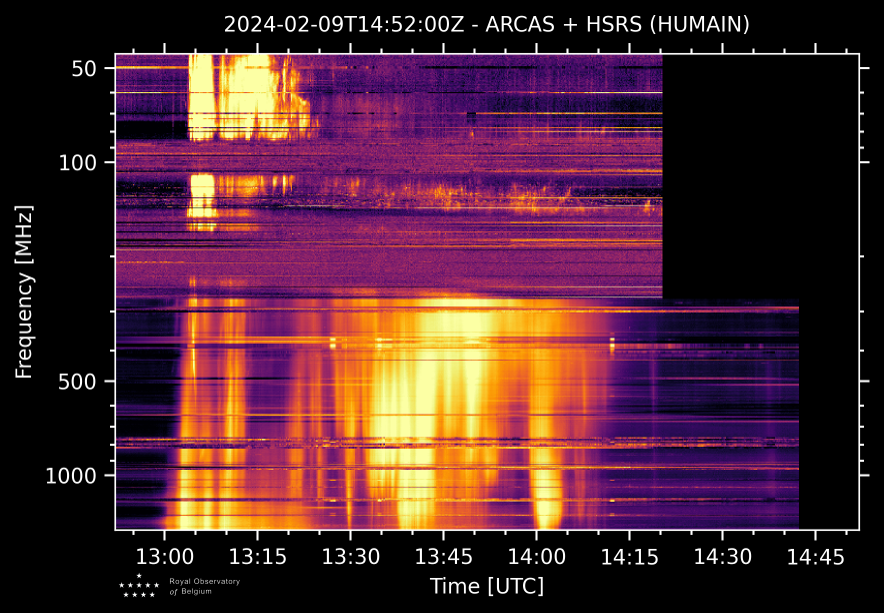A strong X3.3 flare peaked at 13:14 UTC on 09 February. The source region is thought to be NOAA 13575, located well beyond the southwest limb (about 14 degrees!). Consequently, as the Sun is hiding a portion of the event, the eruption must have been significantly stronger than the intensity in soft x-rays seems to convey. Of note is that the last 3 X-class flares, i.e. the X2.8 of 14 December 2023, the X5.0 of 31 December 2023 , and today's X3 flare, are the three strongest flares produced so far this solar cycle. The clip below shows the eruption in extreme ultraviolet at a temperature of several million degrees. The blooming and diffraction patterns in the EUV images are image artefacts, not related to the flare - See this STCE newsitem for more info.

Zooming into the eruption, the clip underneath shows the flare, ejected material to the south, and a prominence that starts "waving" as a flag in the wind as the coronal wave passed by (annotated image). Other AIA wavelengths clearly show a coronal wave propagating through the solar atmosphere (Solar Demon ; annotated image) These are all telltale signs that a coronal mass ejection (CME) was associated with this flare. In view of the location of the source region, the related CME is thought to have no earth-directed component, as also indicated by the SIDC forecaster (PRESTO).

The X3 flare was also associated with a proton event, crossing the alert threshold of 10 pfu at 15:30UTC and currently at 50 pfu. COMESEP had already issued a warning for a possible proton event at 13:40UTC. GOES data show an increase of the fluxes of higher energy protons too, albeit not that impressive (for the moment). HF Communications over the poles may be mildly affected (Polar Cap Absorption), as shown by the D-RAP on the right. The X3 flare itself affected HF Com on the dayside of the Earth, mostly over South-America, Africa, South-Europe and the Atlantic Ocean (D-RAP image on the left). An advisory to civil aviation has been issued (PECASUS/SWPC).

The X-flare was also associated with emission at radio frequencies and as such detected by the Humain Radioastronomy Station in Belgium. Type III and Type II radio bursts were recorded in the radiospectrogram (horizontal axis: time, vertical axis decreasing frequency), as can be seen in the upper left corner of the chart. Also strong broadband radio emission was recorded, covering the frequency range from about 200-1500 MHz during the 13:20-14:10 UTC timespan (Type IV - see the STCE SWx classification page). This means that GNSS based applications might have been briefly impacted, as well as some radars operating at these frequencies.

Further strong flaring events from NOAA 13575 are not expected as the region rotates further onto the farside of the Sun. Soft x-rays from any further flaring event from this region will thus be more and more hidden by the Sun. NOAA 13576, which is currently the largest and most complex active region on disk and close to the central meridian, certainly has a potential to produce strong eruptive events.





